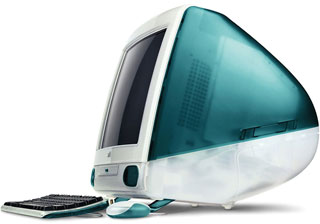August 1998: I’ve been looking forward to the latest issue of PC Magazine, the one that looks at sub-$1,000 (sub-$1K) Windows systems. So many “experts” are chiding Apple for releasing a $1,300 computer when (they say) buyers really want sub-$1K PCs.
I’ve already looked at this in light of PC World’s list of best selling budget PCs in iMac a True Bargain and iMac v. the ‘Top 10’ PCs. The simple fact is that the best selling systems are all more expensive than the iMac.
However, this article looks at the less expensive systems.
 PC Magazine (1 Sept. 1998) examines 37 sub-$1K computers, ranging in price from $759 to $999 – exclusive of the a monitor. Right there we have one big difference between the sub-$1K club and the iMac. Apple’s computer has a built-in 15″ multiscan monitor.
PC Magazine (1 Sept. 1998) examines 37 sub-$1K computers, ranging in price from $759 to $999 – exclusive of the a monitor. Right there we have one big difference between the sub-$1K club and the iMac. Apple’s computer has a built-in 15″ multiscan monitor.
To achieve their sub-$1K price, 29 of these models must be purchased directly from the manufacturer. The iMac can be purchased directly from Apple or from a local retailer.
Processors include 233 MHz to 333 MHz Pentium II, 266 MHz to 300 MHz AMD K6, 300 MHz Cyrix MII, 266 MHz Celeron (the Pentium II sans cache), and last year’s 233 MHz Pentium MMX. At this price level, you’ll find Intel inside 27 of the 37 models, but only 19 use the Pentium II. The iMac uses a 233 MHz PowerPC 750 (a.k.a. G3) processor, which offers performance comparable to the fastest machines PC Magazine tested.
- For those who don’t really keep track of the Wintel world, PC Magazine nicely lists the CPUs in terms of overall performance. From worst to best, they are Intel’s new Celeron/266, Pentium MMX/200 and /233, AMD K6/266, Cyrix MII/300, AMD K6/300, and Pentium II/233 through /333.
The typical sub-$1K computer has a 266 MHz Pentium II, a 3-4 GB hard drive, 4 MB video RAM, a 56k modem, and a 32x CD-ROM. PC Magazine also specified that tested sub-$1K systems must include at least 32 MB RAM, 2 MB video RAM, and a 2 GB hard drive.
Their editor’s choice is the Axis Orion LXN266 selling direct for $995. The budget alternative is the Micro Express MicroFlex-4500 at $899. For those who would rather buy locally, top choices were the Acer Aspire 1832 ($900 street price) and IBM Aptiva E46 ($999 street).
This table compares these computers with the iMac:
| iMac | Orion | MicroFlex | Aspire | Aptiva | |
| CPU | G3/233 | P II/266 | K6/300 | K6/266 | K6/266 |
| L2 cache | 512K | 512K | 1 MB | 256K | 512K |
| Hard drive | 4GB | 6.4GB | 4.3GB | 5.4GB | 4.1GB |
| Modem | 56k | 56k | 56k | 56k | 56k |
| Video RAM | 2 MB | 8 MB | 4 MB | 2 MB | 2 MB |
| Monitor | 15″ | 15″ | 15″ | 15″ | 15″ |
| CD-ROM | 24x | 32x | 32x | 32x | 24x |
| USB ports | 2 | 2 | 2 | 2 | 2 |
| Ethernet | incl. | no | no | no | no |
| Price | $1,299 | $995 | $899 | $900 | $999 |
| + monitor | incl. | $199 | $169 | $199 | $299 |
| + 10/100* | incl. | $99 | $99 | $99 | $99 |
| TOTAL | $1,299 | $1,293 | $1,167 | $1,198 | $1,397 |
Windows systems are configured to best match iMac features. Monitor prices are for the computer manufacturer’s screen.
* price estimated for installed 10/100 ethernet card.
It’s suddenly obvious that the sub-$1K computers really aren’t any less costly than the iMac when you add a 15″ monitor and network card. (It’s odd, but in the Windows world, they still don’t consider networking a standard feature.) And I don’t even want to imagine the quality of sub-$200 monitors.
The table does show that the iMac holds its own against these systems. It might be an easier sell with a 32x CD-ROM, more VRAM, a larger hard drive, or a higher MHz CPU. (Despite the snail ad, the public still looks at MHz as the first measure of performance.)
Regardless, the iMac is a very competent computer, very nicely priced, and very easy on the eyes. I hope this helps dispel the myth that the iMac is overpriced – or that a sub-$1K computer means a sub-$1K computer system.
keywords: #imac #imacvalue

